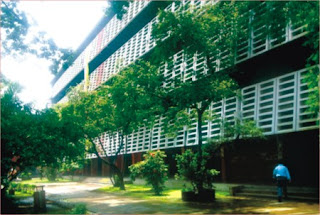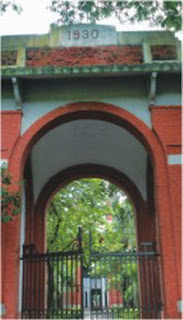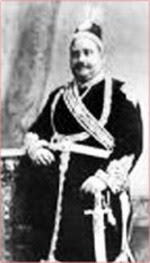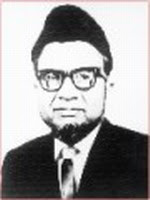

MA Rashid Hall

Civil Engg. building

EME building

Architecture building


Right pic: Nawab Sir Khawaja Salimullah


Left pic: First Principal of Ahsanullah Engineering College Mr. Hakim Ali
Right pic: Founder Vice Chancellor of BUET Prof Dr. MA Rashid.
(pic credit: The daily Star-Campus)
On July 28 last year, the BUET inaugurated a six-month long programme on the campus to celebrate 60 years, from 1947 to 2007, of engineering education in Bangladesh. They wrapped up celebration on December 31, 2007, with programmes, ranging from symposiums and seminars to exhibitions, debates, cultural programmes and sports.
In 1876, the then Govt of Bengal of British India established a Survey School at a rented building at Nolgola (west of Salimullah Medical College) in the old part of Dhaka. It was a two years course to producing men qualified to serve as land surveyors. The Survey School was upgraded to become Ahsanullah School of Engineering, offering three-year diploma courses in Civil, Electrical and Mechanical Engineering and moved to its present premises in 1912. In 1947, the School was upgraded to Ahsanullah Engineering College as a Faculty of Engineering under the Dhaka University, offering four-year bachelor's courses in Civil, Electrical, Mechanical, Chemical and Metallurgical Engineering. In 1948, the Govt. of East Pakistan gave recognition to the Engineering College. Mr. Hakim Ali was appointed the first Principal of the college. The then Vice-Chancellor of Dhaka University, Mahmood Hasan, was the first Vice-Chancellor. In 1951, TH Mathewman was appointed principal and was succeeded in 1954 by Dr. MA Rashid. In 1956 a new course-curricula and the semester system were introduced at the Ahsanullah Engineering College. In 1957, the enrollment capacity for the bachelor's degree was increased from 120 to 240 and the diploma course was withdrawn from 1958.
In order to create facilities for Post Graduate studies and research, the Ahsanullah Engineering College was upgraded and the East Pakistan University of Engineering and Technology was established on 1st June 1962. After Independence of Bangladesh, it was renamed as Bangladesh University of Engineering and Technology in 1971.
After the beginning of the Dhaka Survey School in 1876, three persons' contributions will be remembered forever in the long drawn struggle of BUET. They are Nawab Sir Khwaja Salimullah, Hakim Ali, first Principal of Ahsanullah Engineering College and founder Vice Chancellor of BUET Prof Dr. MA Rashid.
***

Dhaka Engineering Colleger-er Shaat Bochorer Itikotha
Original: Engr. Imam Uddin Ahmed Choudhury, F-493
(former Adviser, Care-Taker Govt. of Bangladesh)
(Translated & abridged: from "Engineering News" July-Aug 2007 Issue)
Regions of Eastern Bengal and Assam in British India remained the most backward and neglected since long. There wasn’t a single medical or engineering college, let alone University, till early 20th century. East Bengal produced 80% of world’s jute, yet hadn’t had any Jute mills. All mills were established in West Bengal, at Kolkata and Howrah along the Hooghly river.
In 1905, British Govt proclaimed a new province for Eastern Bengal and Assam partitioning Bengal with Dhaka as its capital. This aroused unprecedented resentment amongst the middle and elite class of West Bengal. They threatened to unleash “Swadeshi” and non-cooperation movement against British rule. Poet Rabindranath Thakur wrote poem, “Banglar mati, Banglar jol, Banglar bayu, ek hok he Bhagaban.”
To assuage resentment of the assertive and leading politicians British Govt. annulled the partition in 1911. To compensate Eastern Bengal and Assam deprived by annulment, a University was established at Dhaka. West Bengal was not happy with the government's intention to set up a University at Dhaka. They held rallies in Kolkata. One such rally in “Gorer Maidan” on 18 March 1922, was presided over by poet Rabindranath Thakur.
The University of Dhaka finally came into being on 23 Mar, 1920 and took effect from 01 July 1921. Matriculation and Secondary level of education of Bengal, Assam, and Bengali speaking area of Bihar and Orissa remained in the control of Kolkata University in West Bengal.
In 1946, Hussain Shaheed Suhrawardy, the then Chief Minister of Bengal established a Medical and Engineering College at Dhaka. Medical College began functioning in its present premises in 1946 in the converted hospital built for the allied troops of WWII, but functioning of Engineering College in Dhaka delayed by a year due to lack of infrastructure and equipments for the college.
Bengal Engineering College, Shibpur and Kolkata Medical College of West Bengal had few seats reserved for the students of Assam against stipend provided by the Govt. of Assam. Sylhet division of Bangladesh was then a district of Assam. Dr. MA Rashid, Abidur Reza Choudhury and Dr (Maj Gen.) M.R.Choudhury availed the opportunity of education in Bengal Engineering and Kolkata Medical College respectively from Sylhet. For my satisfactory performance in I.Sc. exam in 1947, I became eligible for admission in Bengal Engineering from Assam grant.
But in July 1947 during partition of India, Referendum for Sylhet was held to join India or Pakistan. Sylhet opted for Pakistan. As a result, my admission in Bengal Engineering College, Shibpur stood obscured. Meanwhile, I missed the cut off date for application to Dhaka Engineering College.
I made an appeal to Dhaka Engineering College for admission submitting academic reports. Mr. Hakim Ali, the then Principal Dhaka Engineering College responded promptly in a postcard saying that I should come to Dhaka prepared with Rs. 142/- for admission. In Dhaka, the Registrar of the College asked me to deposit Rs. 6/-in T.C. (Treasury Chalan) in the State Bank of India at Sadarghat. My admission in Dhaka Engineering was completed after depositing Rs. 142/-.
Many of my friends who arrived Dhaka before me were still without admission. Mr. Maqbul Hossain could not deposit money in Govt. Treasury at Sadarghat due to communal tension there. He had to travel to Noakhali to deposit the money in Treasury.
Dhaka Engineering College started functioning in 1947 in the same campus of Ahsanullah School of Engineering. A.S.E. was one of the top rated Engg. School in British India. Although both Institutions functioned in the same campus, they maintained their separate identity. The school portion was moved to Tejgaon Polytechnic Institute after 1958.
Dhaka Engineering College in the first year had seats for 120 students. Communal disturbances and migration throughout India prevented many students to attend respective colleges, many seats remained vacant. Dhaka Engineering College initially suffered from acute shortage of teaching staff. Apart from Principal Hakim Ali (also Principal of School section) Prof. Mohsin Ahmed of Mech. Dept. and Prof. Kabiruddin of Civil Engg. joined Dhaka from Bengal Engineering, Shibpur. To tide over the situation, services of Mr. Foizullah Bhuiyan, Mr. Akbar Ali and teachers of A.S.E. were taken.
Soon, Mr. A Rashid (MS USA), Dr. MA Rashid (D.Sc. Carnegie, USA), Dr Waquar, Prof. MN Azam, Dr. Wahiduddin, Dr. A. Hashnat, Dr. Alimullah Khan, Dr. Abdul Huq, Dr. Naser, Prof. Zahurul Huq, Prof Nazmul Huq, Prof. M.A. Jabbar and many others joined the teaching staff of Dhaka Engineering College.
In 1947, the first year classes of Applied Physics and Applied Chemistry were held in Curzon Hall. Prof Abul Kashem (of Language movement fame) taught our class of Physics and Prof Abdul Quddus took Chemistry. The teachers worked relentlessly with missionary zeal and dedication. Prof Dr. MA Rashid sometimes had to teach 7 periods of 4th year classes in a row.
In the first batch of Dhaka Engineering, 24 graduates came out in 1951 (17 Civil and 7 Elect). But in 1950, when communal riot broke out in Kolkata in large scale, the Muslim students of Bengal Engineering Shibpur of final year living in the campus felt threatened and could not seat in the exam. Dr. FR Khan, Faizul Anam Siddiqui, SM Al-Husainey, MA Gafoor, Golam Rahman Choudhury and MH Khan and some others left Kolkata to join Dhaka Engineereing. Many of them were exceptionally brilliant. (Dr. F.R. Khan became an outstanding structural engineers of the 20th century in his efficient designs for Chicago’s 100-story Hancock Center and 110-story Sears Tower and Hajj Terminal in Jedda Airport, he was also selected Construction's "Man of the Year by Engineering News-Record" in Chicago). They moved to Dhaka. Under the circumstances, Dhaka University arranged special final exam for them in 1950. Dr. FR Khan initially joined East Pakistan Communication and Building Dept in 1951 and I had the opportunity to work with him for some time.
The person who played pivotal role in the development and discipline of Dhaka Engineering College at its nascent stage was its Principal Mr. Hakim Ali. Sher-e-Bangla AK Fazlul Haque, the then Chief Minister of Bengal appointed him as the Principal of the Ahsanullah School of Engineering in 1938. In 1947, when the school was upgraded to Ahsanullah Engineering College, he was appointed the first Principal of the College. He was instrumental in bringing valuable equipments for the College from USA in quick time using his personal influence on MAH Ispahani the then Pak Ambassador to USA. TH Mathewman replaced Hakim Ali as Principal in 1951 and Dr MA Rashid replaced Mathewman in 1954.
There appears some confusion about the name of Dhaka Engineering College. The College was first established as "Dhaka Engineering College" under Dhaka University. In view of the generous financial support of the Dhaka Nawab Family towards development of Education, it was renamed as Ahsanullah Engineering College, Dhaka, after the father of Sir Salimullah. The certificates issued by Dhaka University to the graduates of 1951 however mentioned the name of Institution as “Engineering College, Dhaka.”
In 1876, the then Govt of Bengal of British India established a Survey School at a rented building at Nolgola (west of Salimullah Medical College) in the old part of Dhaka. It was a two years course to producing men qualified to serve as land surveyors. The Survey School was upgraded to become Ahsanullah School of Engineering, offering three-year diploma courses in Civil, Electrical and Mechanical Engineering and moved to its present premises in 1912. In 1947, the School was upgraded to Ahsanullah Engineering College as a Faculty of Engineering under the Dhaka University, offering four-year bachelor's courses in Civil, Electrical, Mechanical, Chemical and Metallurgical Engineering. In 1948, the Govt. of East Pakistan gave recognition to the Engineering College. Mr. Hakim Ali was appointed the first Principal of the college. The then Vice-Chancellor of Dhaka University, Mahmood Hasan, was the first Vice-Chancellor. In 1951, TH Mathewman was appointed principal and was succeeded in 1954 by Dr. MA Rashid. In 1956 a new course-curricula and the semester system were introduced at the Ahsanullah Engineering College. In 1957, the enrollment capacity for the bachelor's degree was increased from 120 to 240 and the diploma course was withdrawn from 1958.
In order to create facilities for Post Graduate studies and research, the Ahsanullah Engineering College was upgraded and the East Pakistan University of Engineering and Technology was established on 1st June 1962. After Independence of Bangladesh, it was renamed as Bangladesh University of Engineering and Technology in 1971.
After the beginning of the Dhaka Survey School in 1876, three persons' contributions will be remembered forever in the long drawn struggle of BUET. They are Nawab Sir Khwaja Salimullah, Hakim Ali, first Principal of Ahsanullah Engineering College and founder Vice Chancellor of BUET Prof Dr. MA Rashid.
***

Dhaka Engineering Colleger-er Shaat Bochorer Itikotha
Original: Engr. Imam Uddin Ahmed Choudhury, F-493
(former Adviser, Care-Taker Govt. of Bangladesh)
(Translated & abridged: from "Engineering News" July-Aug 2007 Issue)
Regions of Eastern Bengal and Assam in British India remained the most backward and neglected since long. There wasn’t a single medical or engineering college, let alone University, till early 20th century. East Bengal produced 80% of world’s jute, yet hadn’t had any Jute mills. All mills were established in West Bengal, at Kolkata and Howrah along the Hooghly river.
In 1905, British Govt proclaimed a new province for Eastern Bengal and Assam partitioning Bengal with Dhaka as its capital. This aroused unprecedented resentment amongst the middle and elite class of West Bengal. They threatened to unleash “Swadeshi” and non-cooperation movement against British rule. Poet Rabindranath Thakur wrote poem, “Banglar mati, Banglar jol, Banglar bayu, ek hok he Bhagaban.”
To assuage resentment of the assertive and leading politicians British Govt. annulled the partition in 1911. To compensate Eastern Bengal and Assam deprived by annulment, a University was established at Dhaka. West Bengal was not happy with the government's intention to set up a University at Dhaka. They held rallies in Kolkata. One such rally in “Gorer Maidan” on 18 March 1922, was presided over by poet Rabindranath Thakur.
The University of Dhaka finally came into being on 23 Mar, 1920 and took effect from 01 July 1921. Matriculation and Secondary level of education of Bengal, Assam, and Bengali speaking area of Bihar and Orissa remained in the control of Kolkata University in West Bengal.
In 1946, Hussain Shaheed Suhrawardy, the then Chief Minister of Bengal established a Medical and Engineering College at Dhaka. Medical College began functioning in its present premises in 1946 in the converted hospital built for the allied troops of WWII, but functioning of Engineering College in Dhaka delayed by a year due to lack of infrastructure and equipments for the college.
Bengal Engineering College, Shibpur and Kolkata Medical College of West Bengal had few seats reserved for the students of Assam against stipend provided by the Govt. of Assam. Sylhet division of Bangladesh was then a district of Assam. Dr. MA Rashid, Abidur Reza Choudhury and Dr (Maj Gen.) M.R.Choudhury availed the opportunity of education in Bengal Engineering and Kolkata Medical College respectively from Sylhet. For my satisfactory performance in I.Sc. exam in 1947, I became eligible for admission in Bengal Engineering from Assam grant.
But in July 1947 during partition of India, Referendum for Sylhet was held to join India or Pakistan. Sylhet opted for Pakistan. As a result, my admission in Bengal Engineering College, Shibpur stood obscured. Meanwhile, I missed the cut off date for application to Dhaka Engineering College.
I made an appeal to Dhaka Engineering College for admission submitting academic reports. Mr. Hakim Ali, the then Principal Dhaka Engineering College responded promptly in a postcard saying that I should come to Dhaka prepared with Rs. 142/- for admission. In Dhaka, the Registrar of the College asked me to deposit Rs. 6/-in T.C. (Treasury Chalan) in the State Bank of India at Sadarghat. My admission in Dhaka Engineering was completed after depositing Rs. 142/-.
Many of my friends who arrived Dhaka before me were still without admission. Mr. Maqbul Hossain could not deposit money in Govt. Treasury at Sadarghat due to communal tension there. He had to travel to Noakhali to deposit the money in Treasury.
Dhaka Engineering College started functioning in 1947 in the same campus of Ahsanullah School of Engineering. A.S.E. was one of the top rated Engg. School in British India. Although both Institutions functioned in the same campus, they maintained their separate identity. The school portion was moved to Tejgaon Polytechnic Institute after 1958.
Dhaka Engineering College in the first year had seats for 120 students. Communal disturbances and migration throughout India prevented many students to attend respective colleges, many seats remained vacant. Dhaka Engineering College initially suffered from acute shortage of teaching staff. Apart from Principal Hakim Ali (also Principal of School section) Prof. Mohsin Ahmed of Mech. Dept. and Prof. Kabiruddin of Civil Engg. joined Dhaka from Bengal Engineering, Shibpur. To tide over the situation, services of Mr. Foizullah Bhuiyan, Mr. Akbar Ali and teachers of A.S.E. were taken.
Soon, Mr. A Rashid (MS USA), Dr. MA Rashid (D.Sc. Carnegie, USA), Dr Waquar, Prof. MN Azam, Dr. Wahiduddin, Dr. A. Hashnat, Dr. Alimullah Khan, Dr. Abdul Huq, Dr. Naser, Prof. Zahurul Huq, Prof Nazmul Huq, Prof. M.A. Jabbar and many others joined the teaching staff of Dhaka Engineering College.
In 1947, the first year classes of Applied Physics and Applied Chemistry were held in Curzon Hall. Prof Abul Kashem (of Language movement fame) taught our class of Physics and Prof Abdul Quddus took Chemistry. The teachers worked relentlessly with missionary zeal and dedication. Prof Dr. MA Rashid sometimes had to teach 7 periods of 4th year classes in a row.
In the first batch of Dhaka Engineering, 24 graduates came out in 1951 (17 Civil and 7 Elect). But in 1950, when communal riot broke out in Kolkata in large scale, the Muslim students of Bengal Engineering Shibpur of final year living in the campus felt threatened and could not seat in the exam. Dr. FR Khan, Faizul Anam Siddiqui, SM Al-Husainey, MA Gafoor, Golam Rahman Choudhury and MH Khan and some others left Kolkata to join Dhaka Engineereing. Many of them were exceptionally brilliant. (Dr. F.R. Khan became an outstanding structural engineers of the 20th century in his efficient designs for Chicago’s 100-story Hancock Center and 110-story Sears Tower and Hajj Terminal in Jedda Airport, he was also selected Construction's "Man of the Year by Engineering News-Record" in Chicago). They moved to Dhaka. Under the circumstances, Dhaka University arranged special final exam for them in 1950. Dr. FR Khan initially joined East Pakistan Communication and Building Dept in 1951 and I had the opportunity to work with him for some time.
The person who played pivotal role in the development and discipline of Dhaka Engineering College at its nascent stage was its Principal Mr. Hakim Ali. Sher-e-Bangla AK Fazlul Haque, the then Chief Minister of Bengal appointed him as the Principal of the Ahsanullah School of Engineering in 1938. In 1947, when the school was upgraded to Ahsanullah Engineering College, he was appointed the first Principal of the College. He was instrumental in bringing valuable equipments for the College from USA in quick time using his personal influence on MAH Ispahani the then Pak Ambassador to USA. TH Mathewman replaced Hakim Ali as Principal in 1951 and Dr MA Rashid replaced Mathewman in 1954.
There appears some confusion about the name of Dhaka Engineering College. The College was first established as "Dhaka Engineering College" under Dhaka University. In view of the generous financial support of the Dhaka Nawab Family towards development of Education, it was renamed as Ahsanullah Engineering College, Dhaka, after the father of Sir Salimullah. The certificates issued by Dhaka University to the graduates of 1951 however mentioned the name of Institution as “Engineering College, Dhaka.”

2 comments:
What an interesing and historical article by Engr. Imam Uddin Ahmed Choudhry
Established in 1997, St. Gregorious Edu-Guidance is a leading education consultancy services providing exemplary service to students all over India. We deal in Admissions to all major professional courses in Premier Institutes across India. We are your one step solution for all career related needs, it may be MD, MBBS BE, BTech (ALL BRANCHES), , MDS, BDS, BPharm, BArch, MBA, MTech, MS, , PhD or any other courses. We provide personalized career solutions on an individual basis keeping in mind the aspirations of our client as well as the affordability factor.
FOR ALL CAREER RELATED NEEDS CONTACT US :
St. Gregorious Edu-Guidance,
#2, 2nd Floor,
J J Complex, Above Chemmannur Jewellers,
Marthahalli - P O,
Bangalore - 560037
Karnataka
e-mail :jojishpaily@gmail.com
Contact: +91 9448516637
+91 9886089896, +91 9449009983
080-32416570, 41719562
Post a Comment